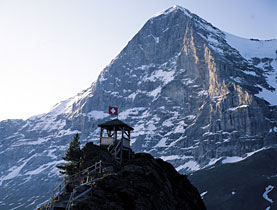Ogre still lurks on the mountain

The infamous north face of Switzerland's Eiger mountain has legendary status among the world's climbers, not least because of the dangers each mountaineer faces.
Although the summit was first reached by an Irishman in 1858, many more years would go by before others dared to tackle the forbidding 1,800-metre rock wall towering above the valley. An exhibition at the Swiss Alpine Museum reveals the stories behind the Eiger myth.
The high point of Eiger fever was in the 1930s when the first attempts were made to conquer the north face in a new era of mountain climbing. The craze was strongest amongst Germans, Austrians and Italians.
After a succession of tragic failures and intense public debate on the ethics of attempting such a dangerous climb, a team of two Germans and two Austrians led by Anderl Heckmair achieved the impossible in 1938.
Perhaps inevitably, the sporting achievement became entangled with politics. The image of Germans and Austrians united in struggle was tailormade for the Nazi propaganda machine, coming just months after the Anschluss – the unification of Austria with Germany.
“Of the four mountaineers, it can said that Heinrich Harrer was a member of the Nazi party, even before the Eiger ascent, and he carried the swastika with him on the climb,” the exhibition’s curator Barbara Gerber told swissinfo.
After the spectacular achievement, the four climbers were invited to a rally in Breslau, now Wroclaw in Poland, to be personally congratulated by Hitler.
“The Nazis published a book about the epic ascent and later there was controversy about what the climbers themselves had written and what was embellished by the publishers,” Gerber said.
Death toll
Public interest was strong again in the 1960s when new routes were established on “the Ogre”. As more climbers fell to their deaths, moral issues came to the fore again.
“There are different opinions on whether climbers should take this risk or not and this still applies today with the speed records that are being attempted,” Gerber said.
Climbers attempting the north face have to contend with deadly landmarks like the Ice Hose, Death Bivouac, Brittle Ledges and Traverse of the Gods. To date 65 people have lost their lives on the north face.
In 1957, an Italian climber died on the mountain and rescuers were unable to reach his body. For two years it hung there, a macabre symbol of the “wall of death”.
This has done little to deter mountaineers. Today’s generation of extreme climbers seeks new records and ever-greater challenges. Gerber shares the disbelief of many observers.
“Last year Ueli Steck set a speed record of three hours and 45 minutes on the Heckmair route which people thought was surely the fastest possible time. It seemed unbeatable and crazy and now this year he slashed his record by more than one hour. That is unimaginably fast.”
Rock falls
The ascent is more often attempted in winter because it is safer. A huge problem on the north face is rock falls.
“In summer when the face is not frozen there is a much higher risk of rock fall whereas in winter the loose rock is frozen solid,” Gerber explains.
In the past there was more climbing in summer because they didn’t have the equipment to attempt winter climbs.
The first person to reach the summit of the Eiger was 24-year-old Irishman Charles Barrington 150 years ago. He reached the top by the west flank.
Barrington was a jockey and casual climber who made only one visit to the Alps. He was looking for a peak that hadn’t yet been reached and set out for the Eiger in August 1858 with two local guides Christian Almer and Peter Bohren, much to the consternation of their families.
“When leaving Grindelwald for the Eiger I was surprised to see the families of the guides in a state of distraction at their departure for the ascent, and two elderly ladies came out and abused me for taking the guides to risk their lives,” Barrington recalled in a letter written 24 years later.
The young adventurer put his success down to his level of fitness. “Had I not been as fit as my old horse Sir Robert Peel when I won the Irish Grand National with him, I would not have seen half the course.”
The exhibition Rock and Risk at the Swiss Alpine Museum in Bern gives a behind-the-scenes look at the challenge of the Eiger since the first ascent of the mountain 150 years ago.
A book about the Eiger climbers of the 1930s by German writer Reiner Rettner has been published in parallel with the exhibition. “Eiger – Triumph and Tragedy 1932 to 1938” presents new evidence from contemporary sources about the Nazi connection.
The 1,800-metre wall above the resort of Grindelwald in the Bernese Oberland has one of the most daunting reputations in the climbing world. It is steep, exposed to bad weather, almost always hidden in shadow, and presents alternating patches of rock and ice.
Anyone prepared to climb it also faces the risk of being hit by falling rocks.
It remained unconquered until 1938. Germans Anderl Heckmair and Ludwig Vorg teamed up with Heinrich Harrer and fellow Austrian Fritz Kasparek to make the first ascent.

In compliance with the JTI standards
More: SWI swissinfo.ch certified by the Journalism Trust Initiative













You can find an overview of ongoing debates with our journalists here . Please join us!
If you want to start a conversation about a topic raised in this article or want to report factual errors, email us at english@swissinfo.ch.